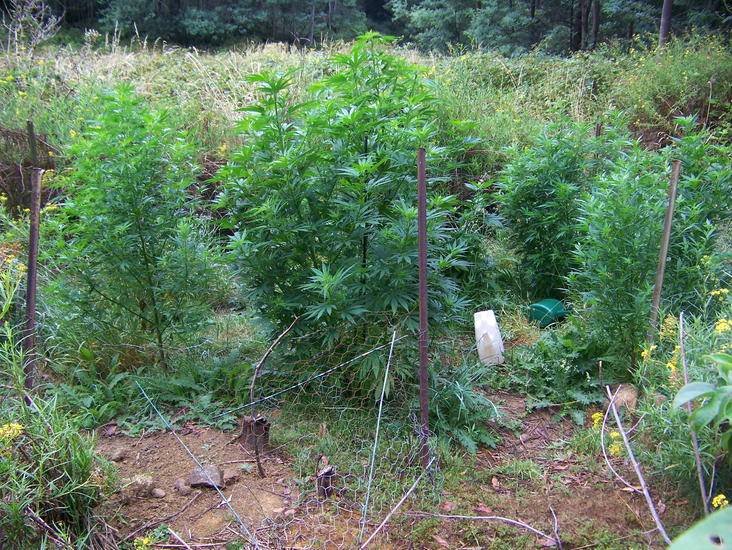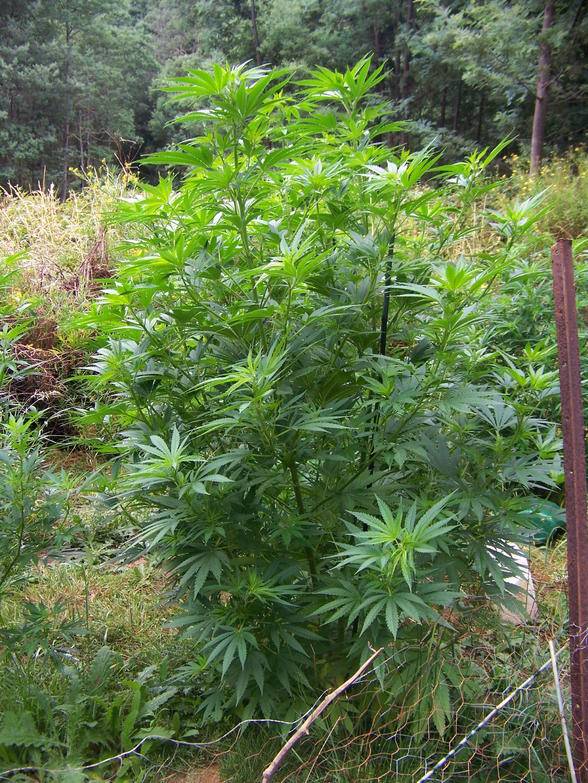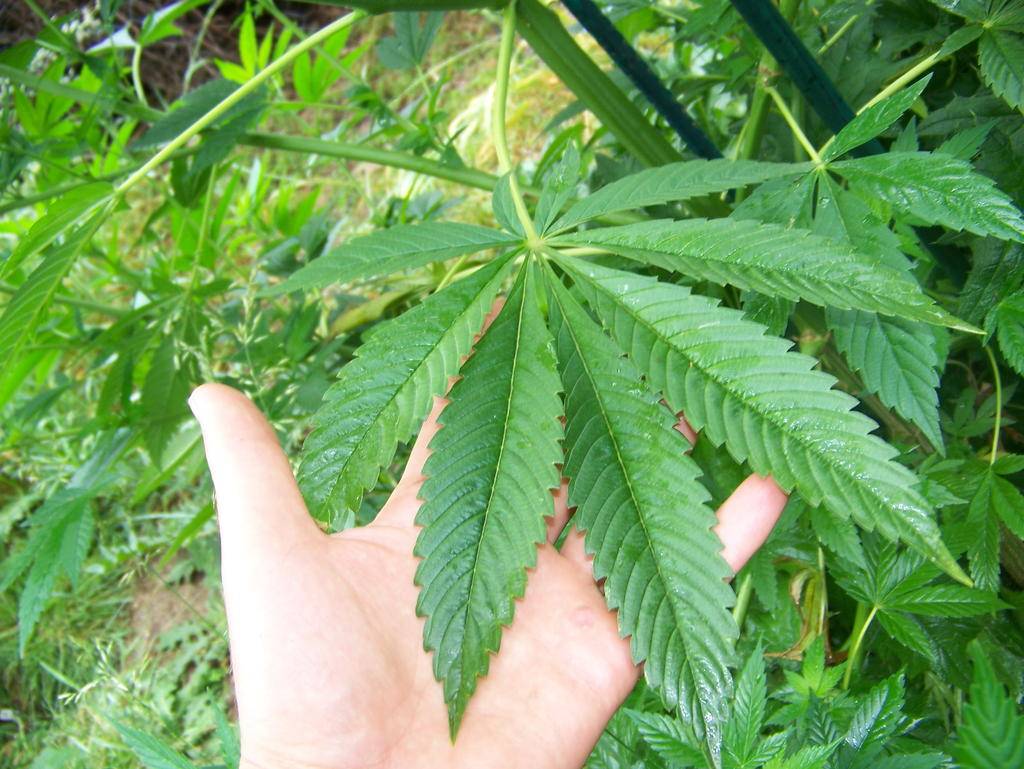I stand corrected i just didnt see any other types while i was there, and there was a big assorment. O well for the time being im not dissapointed, i just needed some and found the quick fix.
-
Happy Birthday ICMag! Been 20 years since Gypsy Nirvana created the forum! We are celebrating with a 4/20 Giveaway and by launching a new Patreon tier called "420club". You can read more here.
-
Important notice: ICMag's T.O.U. has been updated. Please review it here. For your convenience, it is also available in the main forum menu, under 'Quick Links"!
You are using an out of date browser. It may not display this or other websites correctly.
You should upgrade or use an alternative browser.
You should upgrade or use an alternative browser.
Terra Preta - Dark Soil - Experiment
- Thread starter SilverSurfer_OG
- Start date
High there fellow green/black/brown fingered ones and bearers of dirty finger nails! 
Thought i would share some pics of this seasons garden. This spot is heavy clay soil that i dug fairly large holes and chucked in all my old compost heap and recycled coco/perlite/soil mixes. Along with all my charcoal experiments and amendments since i started buggering around with this stuff.
There is also some stinky roadkill that me and a mate scraped off the tarmac and buried in 4 out of 7 holes...
Girls are NL, Reclining Buddah, White Rhino and (C99 x Blueberry) x Chem D.




Thought i would share some pics of this seasons garden. This spot is heavy clay soil that i dug fairly large holes and chucked in all my old compost heap and recycled coco/perlite/soil mixes. Along with all my charcoal experiments and amendments since i started buggering around with this stuff.
There is also some stinky roadkill that me and a mate scraped off the tarmac and buried in 4 out of 7 holes...
Girls are NL, Reclining Buddah, White Rhino and (C99 x Blueberry) x Chem D.
Cameroon Terra Preta test
Cameroon Terra Preta test
http://urbangardenmagazine.com/issues/issue-8/
you have to open the issue and go to page #14
Cameroon tests terra preta
Cameroon Terra Preta test
http://urbangardenmagazine.com/issues/issue-8/
you have to open the issue and go to page #14
Cameroon tests terra preta
S
secondtry
Eh,
Thanks for the heads up but didn't really like that article, nor that magazine, what a bunch of idiots! AM fungi in hydroponics with chemical ferts? WTF? Dumbasses. I told them as much too, and I told them to stop spreading wrong info. And they think fungus is plural. For some odd reason they also think a glove box should have a HEPA filter and air movement, geeze they just don't' know shit, glove box is a still air piece of equipment.
Thanks for the heads up but didn't really like that article, nor that magazine, what a bunch of idiots! AM fungi in hydroponics with chemical ferts? WTF? Dumbasses. I told them as much too, and I told them to stop spreading wrong info. And they think fungus is plural. For some odd reason they also think a glove box should have a HEPA filter and air movement, geeze they just don't' know shit, glove box is a still air piece of equipment.
Well said, I'd tear them a new one too if I could be bothered I only slaughter local idiots.
It's fine to be wrong, printing it as gospel is just phukked.
I don't like the sound of the cowboy brand having ply in it. Those glues and treatment agents are toxic nasty crap. Probably a mistake but I would check them out if they char plywood the other wood is likely full of cadmium arsenic and other highly undesirable rubbish.
To save yourself grief:
Worm test. Dig over a cubic foot of soil, half fill it woth food scraps, leaf mulch etc, put in some freshly crushed char and cover in remaining soil. Come back a month later. Is it filled with worms? Including both composting and earthworms?
If it's not, it's rubbish, and toxic.
It's fine to be wrong, printing it as gospel is just phukked.
I don't like the sound of the cowboy brand having ply in it. Those glues and treatment agents are toxic nasty crap. Probably a mistake but I would check them out if they char plywood the other wood is likely full of cadmium arsenic and other highly undesirable rubbish.
To save yourself grief:
Worm test. Dig over a cubic foot of soil, half fill it woth food scraps, leaf mulch etc, put in some freshly crushed char and cover in remaining soil. Come back a month later. Is it filled with worms? Including both composting and earthworms?
If it's not, it's rubbish, and toxic.
were did u read this fista?I don't like the sound of the cowboy brand having ply in it. Those glues and treatment agents are toxic nasty crap. Probably a mistake but I would check them out if they char plywood the other wood is likely full of cadmium arsenic and other highly undesirable rubbish.
.
i did a search once i read this and this is what i found
http://www.nakedwhiz.com/lumpdatabase/lumpbag6.htm
from http://www.nakedwhiz.com/lumpdatabase/lumpbag6.htm#otherinfoThe following comes from an email (posted on The BBQ Forum) from Cowboy Charcoal customer service regarding the use of scrap lumber in their lump. Personally, we don't object to the use of scrap lumber to make lump. We don't prefer it either. Whatever your opinion might be, we thought you would be interested in this additional information:
"As always, we stand by that we have only 100% natural hardwood charcoal made from oak, maple and hickory woods.
The wood that we use comes from the lumber industry in Kentucky. However, I assure you that none of it has been treated or has any chemicals on it. Much of the wood that we aquire (sic) is conserved from the kiln dried lumber industry. Much of this product is further processed into tounge (sic) and groove flooring material. Most of our raw material stream comes from the process before it is routed. However, occasionally a piece is rejected after it grooved and joins our raw material stream. Some flooring manufacturers are now prevarnishing their product. However, none of the mills that we resource (sic) from offer this product and no varish (sic) is used in their proccesses. I hope this helps reasure you! Please sontact us if you have any other questions!"
what do you guys think? should we use this stuff?
If they're not lying it sounds fine. Someone mentioned plywood, it's rare to get plywood untreated, it's definately glued...
Me, I'm way fussy about my source of char as it can take years for a screw up to correct itself. You did the right thing doing the research.
If Jay likes it, and the worm test comes out shining, I say it's ok and the ply may have been some peeling tongue and groove.
Write to them and tell them you want it for your garden, they might tell you all sorts of neat information. You might convince them to start making amended bio-char. Which would rock, they're a widespread company.
Me, I'm way fussy about my source of char as it can take years for a screw up to correct itself. You did the right thing doing the research.
If Jay likes it, and the worm test comes out shining, I say it's ok and the ply may have been some peeling tongue and groove.
Write to them and tell them you want it for your garden, they might tell you all sorts of neat information. You might convince them to start making amended bio-char. Which would rock, they're a widespread company.
I overcommitted with the cowboy a bit I think. Put it in most of my worm bins. I'll know soon enough!
2 videos on terra preta/ bio char
2 videos on terra preta/ bio char
2 vidoes on terra preta & biochar
http://www.youtube.com/watch?v=1-hSl59ET2A&feature=player_embedded
http://www.youtube.com/watch?v=M6EPKYp5UgI&feature=related
http://www.biochar-international.org/
2 videos on terra preta/ bio char
2 vidoes on terra preta & biochar
http://www.youtube.com/watch?v=1-hSl59ET2A&feature=player_embedded
http://www.youtube.com/watch?v=M6EPKYp5UgI&feature=related
http://www.biochar-international.org/
Hey my wife and I just watched an episode of national geographic explorer on the hulu, titled "lost cities of the amazon".
Anyway it talks about terra preta of course, and how many people this man made soil supported, but 95% were wiped out probably by disease.
get this: the area they calculated was covered by the TP from this civilization is roughly equal to the area of France.
Anyway it talks about terra preta of course, and how many people this man made soil supported, but 95% were wiped out probably by disease.
get this: the area they calculated was covered by the TP from this civilization is roughly equal to the area of France.
woods hole study biochar
woods hole study biochar
A critical look at char use in soils from Woods Hole.
I notice his char came from hardwoods. The terra preta char of
Brazil came from savana grass, was much finer & perhaps a different ph than Woods Hole found.
http://www.youtube.com/watch?v=kX7vMAC2cSQ&NR=1
woods hole study biochar
A critical look at char use in soils from Woods Hole.
I notice his char came from hardwoods. The terra preta char of
Brazil came from savana grass, was much finer & perhaps a different ph than Woods Hole found.
http://www.youtube.com/watch?v=kX7vMAC2cSQ&NR=1
http://www.biochar-international.org/profiles/centralamerica/stoves
about biochar stoves
about biochar stoves
xebeche
Member
I have not read this entire thread, but was discussing it with CC (to whom I am indebted for teaching me about soil among other things). After reading the first few pages and the last couple, I was wondering if anyone had considered if the black soil described with the broken pieces of pottery seemed to have more than simply a terra petra (charcoal) but that the broken pottery could potentially be an excellent breeding ground for microbes (like pumice) and that the blackness of the soil could have included some form(s) of Humic Acid. Anyone got any leads or links as to the validity of this train of thought?
Yay how cool my 1st sticky! 
Glad this thread has been of value to our community.
Charcoal is certainly an excellent home for microbes and the pottery as well i imagine xebeche. As for the humus yes i am very sure over time it would be good source. The main reason i like char is its ability to hold on to nutrients and prevent them leaching from soil/soiless mixes. A little goes a long way. Just be sure to marinate it it 1st!
Glad this thread has been of value to our community.
Charcoal is certainly an excellent home for microbes and the pottery as well i imagine xebeche. As for the humus yes i am very sure over time it would be good source. The main reason i like char is its ability to hold on to nutrients and prevent them leaching from soil/soiless mixes. A little goes a long way. Just be sure to marinate it it 1st!

I have not read this entire thread, but was discussing it with CC (to whom I am indebted for teaching me about soil among other things). After reading the first few pages and the last couple, I was wondering if anyone had considered if the black soil described with the broken pieces of pottery seemed to have more than simply a terra petra (charcoal) but that the broken pottery could potentially be an excellent breeding ground for microbes (like pumice) and that the blackness of the soil could have included some form(s) of Humic Acid. Anyone got any leads or links as to the validity of this train of thought?
Now hang on. Terra preta is not charcoal. It is a man made soil that renews itself, developed by Amerindians. No one alive today knows how to make it.
S
schwagg
cowboy charcoal isn't the greatest. neither is Kingsford charwood that is sold at fred meyers. it's full of lumber, not wood. the best i can find is lazzari 40 lb bags for 16 bucks at cash & carry. by the time you get to the bottom of the bag, it's dust down there. look it up if you live near one.
Isn't lumber made of wood?
xebeche
Member
Hrm,
I think my point was missed. As far as the charcoal goes, anything with glues or heavy metals (PT lumber) should be avoided for obvious reasons. Is this thread about terra petra or adding charcoal (or where they overlap)? The point I was trying to make was that we are probably missing something (per the description of the specific terra petra) that the makers of the terra petra either knew (scientifically) or happened across and noticed a benefit. There are countless forms of charcoal and obviously it is valid to discuss the potential benefits of using charcoal soil. I was trying to ask if anyone had looked in to the other parts of the old soil from the Amazon Basin or could point me in a direction of someone who had done a scientific (or pseudo-scientific) study on what else was in the soil (aside from charcoal).
If anyone can point me in the right direction I would appreciate it.
X
I think my point was missed. As far as the charcoal goes, anything with glues or heavy metals (PT lumber) should be avoided for obvious reasons. Is this thread about terra petra or adding charcoal (or where they overlap)? The point I was trying to make was that we are probably missing something (per the description of the specific terra petra) that the makers of the terra petra either knew (scientifically) or happened across and noticed a benefit. There are countless forms of charcoal and obviously it is valid to discuss the potential benefits of using charcoal soil. I was trying to ask if anyone had looked in to the other parts of the old soil from the Amazon Basin or could point me in a direction of someone who had done a scientific (or pseudo-scientific) study on what else was in the soil (aside from charcoal).
If anyone can point me in the right direction I would appreciate it.
X
S
schwagg
lumber is made out of wood, but if i'm cooking or growing a garden, i don't want milled lumber in my charcoal. who knows what it's been treated with. good charcoal should be real wood: branches, stumps, twigs.... just trying to give a heads up. back to terra petra
Hrm,
I think my point was missed. As far as the charcoal goes, anything with glues or heavy metals (PT lumber) should be avoided for obvious reasons. Is this thread about terra petra or adding charcoal (or where they overlap)? The point I was trying to make was that we are probably missing something (per the description of the specific terra petra) that the makers of the terra petra either knew (scientifically) or happened across and noticed a benefit. There are countless forms of charcoal and obviously it is valid to discuss the potential benefits of using charcoal soil. I was trying to ask if anyone had looked in to the other parts of the old soil from the Amazon Basin or could point me in a direction of someone who had done a scientific (or pseudo-scientific) study on what else was in the soil (aside from charcoal).
If anyone can point me in the right direction I would appreciate it.
X
We have discussed this previously. I suggest reading the whole thread.
Cheers.


